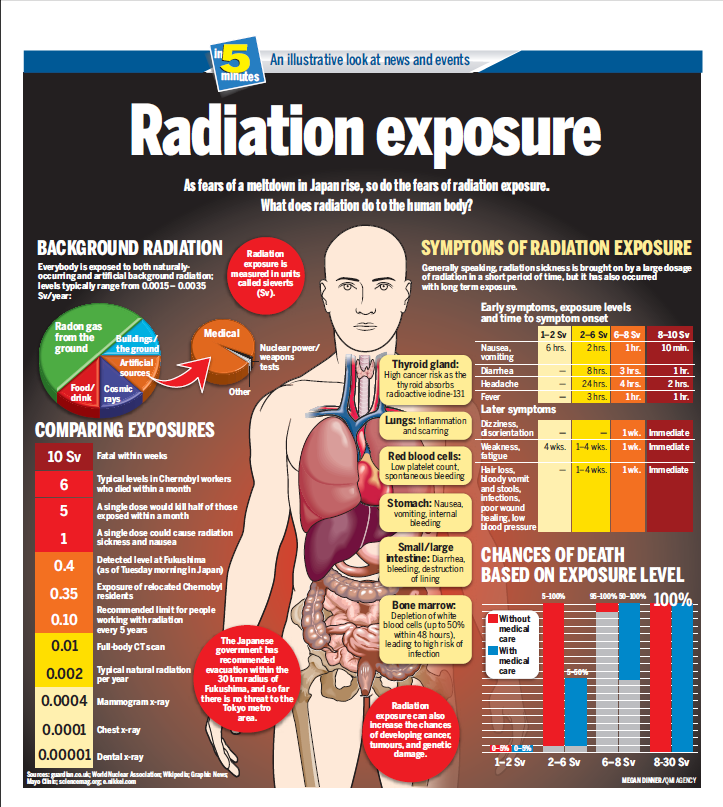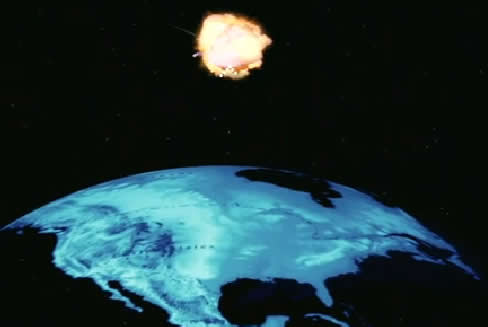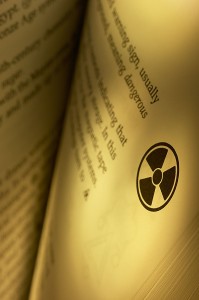RADIOACTIVE FALLOUT
Fallout arriving within a few hours after a nuclear explosion is highly radioactive. If it collects on the skin in large enough quantities it can cause beta burns. People who are caught outside in fallout should brush fallout particles off themselves and shake out their outer garments as soon as they get inside. Some people may be carrying umbrellas and wearing raincoats to keep the fallout particles off their skin and hair.
Most fallout particles will be like grains of fine, dark sand and can be easily brushed off from dry surfaces. Fallout particles may stick to moist or oily surfaces, including sweaty or oily skin or hair. These surfaces should be carefully wiped or washed off. If contaminated hair cannot be washed, it should be thoroughly brushed or combed, with frequent shaking and wiping of the hair and also of the brush or comb. It is not necessary to get the last speck of fallout out of the clothing or hair or off the skin. A few grains of fallout carried by each person into the safest parts of the home or shelter will produce no noticeable increase in the radiation hazard and will not be detectable by the radiological instruments. Daily sweeping of the area for hygienic reasons will eliminate most fallout particles that may be carried into the area even after decontamination procedures. After they have shaken out their clothing and wiped off their exposed skin, they should dust off their shoes with a brush or broom before moving further into the shelter and sweep the area. If the shoes are caked with mud or dust, they should be left in the quarantine area or outside. Because the fallout particles will fall down to the floor, decontamination of a person should begin with the head and end with the feet. Brushing off or removing the shoes will be the last step of decontamination before a person enters the safer parts of your home or shelter.
TAKING POTASSIUM IODIDE (KI)
Potassium iodide, also called KI, only protects a person’s thyroid gland from exposure to radioactive iodine. KI will not protect a person from other radioactive materials or protect other parts of the body from exposure to radiation. It must be taken prior to exposure (for example, if people hear that a radioactive cloud is coming their way) or immediately after exposure to be effective. Taking KI is not recommended unless there is a risk of exposure to radioactive iodine which is a major uranium fission product and of fissionable materials used in nuclear power plants. Taking (KI) is most advisable in the event of a radioactive dirty bomb detonation or meltdown of a nuclear power plant. KI (potassium salts) saturate the thyroid preventing it from absorbing radioactive iodine. The most likely scenario is radioactive fallout from a nuclear power plant meltdown, even possibly fallout originating from far overseas, but would at the most only require 10-14 days protection from radioiodine by taking Potassium Iodide (KI) tablets and having pre-stocked safe food and water in case people panic and stampede food stores.
USING IODINE TO SHIELD AGAINST RADIATION
In an emergency, if you are unable to acquire KI tablets, you can topically (on the skin) apply an iodine solution, like tincture of iodine or Betadine, for a similar protective effect. (WARNING: Iodine is NEVER to be ingested or swallowed, it is poison to drink.) For adults, paint, 8 ml of a 2 percent tincture of Iodine on the abdomen or forearm each day, ideally at least 2 hours prior to initial exposure for absorption. For children 3 to 18, but under 150 pounds, only half that amount painted on daily, or 4 ml. For children under 3 but older than a month, half again, or 2 ml. For newborns to 1 month old, half it again, or just 1 ml. (One measuring teaspoon is about 5 ml, if you don’t have a medicine dropper graduated in ml.) If your iodine solution is stronger than 2%, reduce the dosage accordingly.
Absorption through the skin is not as reliable a dosing method as using the tablets, but tests show that it will still be very effective for most. Use half these doses when using 10% providone iodine solution.
DRINKING RED WINE TO SHIELD AGAINST RADIATION

One of the isotopes likely to be released in a fissionable reactor is strontium 90, which is absorbed in the bones as beta radiation because it´s chemically similar to calcium. So you end up with nuked bones cooking you up from the inside out, same as beta radiation from radioactive ash fallout following a nuclear detonation. Wine, and apparently red in particular, contains strontium 85 which is non radioactive, so if you load up on red wine following a nuclear detonation or reactor meltdown, you saturate the amount of strontium your body can absorb with the non-radioactive strontium 85 and thus the bad isotope strontium 90 just passes through in your urine unable to attach to the bones.
DRINKING LIQUOR TO FLUSH RADIATION

Drinking liquor helps flush radioactive alpha particles that have been ingested through your system by acting as a diuretic forcing your body to dump excess water. This of course can probably be achieved by drinking copious amounts of water but would not be anywhere near as much fun. Plus, the effects of alcohol may help alleviate the stress of the situation in which you are currently in. Some argue that another reason to use liquor instead of water is that alcohol makes the blood viscous preventing particles that lodge in the bones from being able to get to the bones and are flushed out in the urine, either way you had me sold at liquor. Apparently this is what the general Russian public was taught during the cold war in order for them to protect themselves following a nuclear war from radiation. They were told to drink vodka as it was their responsibility to the state to remain alive and fit to help rebuild the country in order to ensure they were able to strike back at their enemies, you’ve gotta love their survivalist mindset.
For more information about radiation, check the following Websites: www.epa.gov/radiation, or www.orau.gov/reacts/define.htm,






